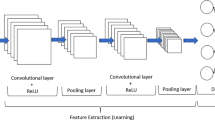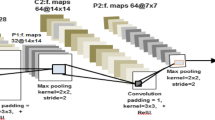Abstract
Processing high-dimensional remote sensing images data with conventional convolutional neural networks raises certain issues such as prolonged model convergence time, vanishing gradient, convergence of the non-minimum values, etc. due to its high time-complexity and random initialization parameters nature. Aiming at those issues, this article proposes a convolutional neural network remote sensing classification model based on PTL-CFS. This model approach first utilizes parameter transfer learning algorithm to obtain the CNN initialization parameters of the target area, then it uses correlation-based feature selection algorithm to eliminate the redundant features and noises from the original feature set, finally, it classifies the remote sensing images using a conventional CNN model. This article has proven the validity of such network model when classifying remote sensing images in the Zha long wetland, Heilongjiang. Experiments show that the addition of PTL can accelerate the loss function of the convergence rate in CNN. The algorithm combined with CFS algorithm, compared with other algorithms to reduce the algorithm execution time and get better classification accuracy.






Similar content being viewed by others
References
Linlin Xu, Jonathan Li (2014) Bayesian classification of hyperspectral imagery based on probabilistic sparse representation and markov random field. Geosci Remote Sens Lett IEEE 11(4):823–827
Pacifici F, Chini M, Emery WJ (2009) A neural network approach using multi-scale textural metrics from very high-resolution panchromatic imagery for urban land-use classification. Remote Sens Environ 113(6):1276–1292
Huang X, Zhang L (2013) An SVM ensemble approach combining spectral, structural, and semantic features for the classification of highresolution remotely sensed imagery. IEEE Trans Geosci Remote Sens 51(1):257–272
Liu C, Hong L, Chen J et al (2015) Fusion of pixel-based and multi-scale region-based features for the classification of high-resolution remote sensing image. J Remote Sens 19(2):228–239
Bengio Y (2009) Learning deep architectures for AI. Found Trends Mach Learn 2(1):1–127
Bottou L (2007) Large-scale kjernel machines [M]. MIT Press, Cambridge, pp 321–359
LeCun Yann, Bottou Leon, Bengio Yoshua et al (1998) Gradient-based learning applied to document recognition. Proc IEEE 86(11):2278–2324
LeCun Y, Boser B, Denker JS et al (1989) Backpropagation applied to handwritten zip code recognition. Neural Comput 11(4):541–551
Lawrence S, Giles CL, Tsoi AC et al (1997) Face recognition: a convolutional neural-network approach. IEEE Trans Neural Netw 8(1):98–113
Neubauer Claus (1998) Evaluation of convolutional neural networks for visual recognition. IEEE Trans Neural Netw 9(4):685–696
Kai Yu, Lei Jia, Yuqiang Chen et al (2013) Deep learning: yesterday, today, and tomorrow. J Comput Res Dev 50(9):1799–1804 (in Chinese)
Krizhevsky A, Sutskever I, Hinton G (2012) Image net classification with deep convolutional neural networks. In: Proceedings of advances in neural information processing systems, Lake Tahoe, USA, pp 1097–1105
Ouyang W, Wang X (2013) Joint deep learning for pedestrian detection. In: Proceedings of the 2013 IEEE international conference on computer vision. Sydney, Australia: IEEE, pp 2056–2063
Thomas S, Ganapathy S, Saon G, et al (2014) Analyzing convolutional neural networks for speech activity detection in mismatched acoustic conditions. In: Proceedings of the IEEE international conference on acoustics, speech and signal processing (ICASSP), Florence, Italy, pp 2519–2523
Hinton Geoffrey, Deng Li, Dong Yu et al (2012) Deep neural networks for acoustic modeling in speech recognition: the shared views of four research groups. IEEE Signal Process Mag 29(6):82–97
Huang JT, Li JY, Gong YF (2015) An analysis of convolutional neural networks for speech recognition. In: Proceedings of the IEEE international conference on acoustics, speech and signal processing (ICASSP), Brisbane, Australia, pp 4989–4993
Abdel-Hamid O, Mohamed A, Jiang H, et al (2012) Applying convolutional neural networks concepts to hybrid NN-HMM model for speech recognition. In: Proceedings of the IEEE international conference on acoustics, speech and signal processing (ICASSP), Kyoto, Japan, pp 4277–4280
Abdel-Hamid Ossama, Mohamed Abdel-rahman, Jiang Hui et al (2014) Convolutional neural networks for speech recognition. IEEE/ACM Trans Audio Speech Lang Process 22(10):1533–1545
Sui TT, Wang XF (2016) Convolutional neural networks with candidate location and multi-feature fusion. Acta Autom Sin 42(6):875–882
Yue Q, Ma C (2017) A deep convolution neural network for object detection based. Harbin Gongye Daxue Xuebao/J Harbin Inst Technol 49(5):159–164
Dai WY, Chen YQ, Xue GR, Yang Q, Yu Y (2008) Translated learning: Transfer learning across different feature spaces. In: Koller D, Schuurmans D, Bengio Y, Bottou L (eds) Proc of the advances in neural information processing systems, vol 20. MIT Press, Cambridge, pp 353–360
Zhu Y, Chen Y, Lu Z, Pan SJ, Xue GR, Yu Y, Yang Q (2011) Heterogeneous transfer learning for image classification. In: Burgard W, Roth D (eds) Proc. of the AAAI. AAAI Press, pp 1304–1309
Wei HL, Billings SA (2007) Feature subset selection and ranking for data dimensionality reduction. IEEE Trans Pattern Anal Mach Intell 29(1):162–166
Guyon I, Elisseeff A (2003) An introduction to variable and feature selection. J Mach Learn Res 3:1157–1182
Huang FJ, LeCun Y (2006) Large-scale learning with SVM and convolutional for generic object categorization. In: Proceedings of the 2006 IEEE computer society conference on computer vision and pattern recognition. IEEE, New York, USA, 284–291
Evgeniou T, Pontil M (2004) Regularized multi–task learning[C]. In: Tenth ACM SIGKDD international conference on knowledge discovery and data mining. ACM, pp 109–117
Yu XD, et al (2017) Wetland remote sensing classification using support vector machine optimized with co-evolutionary algorithm. In: 16th IEEE/ACIS international conference on computer and information science (ICIS), Chins, Wuhan, pp 4277–4280
Zang SY, Zhang C, Zhang LJ et al (2012) Wetland remote sensing classification using support vector machine optimized with genetic algorithm: a case study in Honghe Nature National Reserve. Sci Geogr Sin 32(4):434–441
Wang J, Lei Z, Chen G (2012) A parameter optimization method for an SVM based on improved grid search algorithm. Appl Sci Technol 39(3):28–31
Author information
Authors and Affiliations
Corresponding author
Rights and permissions
About this article
Cite this article
Yu, X., Dong, H. PTL-CFS based deep convolutional neural network model for remote sensing classification. Computing 100, 773–785 (2018). https://doi.org/10.1007/s00607-018-0609-6
Received:
Accepted:
Published:
Issue Date:
DOI: https://doi.org/10.1007/s00607-018-0609-6
Keywords
- Convolutional neural network
- Parameter transfer learning
- Correlation-based feature selection
- Remote sensing classification




